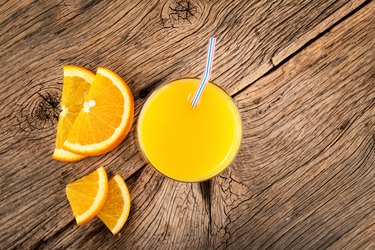
Virtually all types of juice — from classic apple, orange and grape to juices made from peaches or vegetables — contain organic acidic juices. Each fruit and vegetable contains a slightly different combination of acids, and each acid is associated with a different degree of tartness.
Read more: 10 Irresistible Smoothies to Make Right Now
Video of the Day
Video of the Day
Acidic Juices and pH Levels
Understanding acid content of juices can help you with your nutritional needs. If you experience kidney stones or hypocitraturia — a health condition in which you excrete too little citrate per day — elevating your acidic juice intake in your diet can help enhance citrate excretion, according to a July 2015 study from Clinical Nutrition Research. For others with gastrointestinal distress, such as acid reflux disease or ulcers, limiting acidic foods and focusing on a diet heavy in alkaline foods is essential.
For those following a specific acidic diet, you should remain cognizant of where your food falls on the pH scale — a hierarchy of food acidic levels. Based on a range of zero to 14, a pH of 7 is neutral, while zero is the most acidic. The lower the pH score, the more acidic the juice.
The acidic juices' pH levels are as follows, according to the Bad Bug Book (Second Edition), published by the U.S. Food & Drug Administration (FDA):
- Juices made from lemons and limes are the most acidic. They rate between 2 and 2.8 on the pH scale, which explains why they taste bitter and need mixing with water and sweeteners.
- The fruits often used to make juice — such as apples, oranges, peaches, pears, strawberries and blueberries — all have about the same level of acidity, with pH scores ranging from 3.12 to 4.6. If your juice includes some bananas, the acidity may be neutralized a little because their pH level is 4.5 to 5.2.
- Most vegetable juices are significantly less acidic than fruit juices, but their pH will vary depending on the mix of veggies and fruits used in the juice. Veggies commonly used to make green juices, such as spinach, cucumber and celery, all have pH scores in the range of 5.12 to 6+. If you're looking for a more acidic diet, adding in extra fruit to green juices can raise the pH level.
- Tomatoes are technically fruits, which is why the pH of tomato juice, 4.3 to 4.9, is more acidic than other vegetable juices.
Acids in Fruit Juices
You will find different types of acid within juice, which include the following:
- Citrus fruits contain citric acid as their primary acid. Citric acid occurs naturally, according to an August 2018 study from Toxicology Reports. This study also states that the USDA Nutrient Database doesn't provide consumers information on the citric acid levels of foods. If you want to stick with a more alkaline diet, limiting your intake of the above fruits and focusing more on consuming green veggies can help.
- Manufacturers will also use citric acid as a food additive to provide a sourer taste to sweet juices, per Toxicology Reports.
- Malic acid, a naturally occurring acid with a less acidic taste than citric acid (but a tart flavor overall), remains predominant in apples, grapes, peaches, prunes, pears and bananas. Runners might be interested in supplementing their diet with malic acid and creatine. In a March 2015 study from Acta Physiologica Hungarica, researchers determined the effects of creatine malate on runners. They found that with sprinters, the malic acid and creatine caused a significant enhanced physical performance effect, anaerobic exercise ability and an elevated growth hormone.
Read more: 10 Ultimate Smoothies for Any Time of Day
- Toxicology Reports: "Potential Role of the Common Food Additive Manufactured Citric Acid in Eliciting Significant Inflammatory Reactions Contributing to Serious Disease States: A Series of Four Case Reports"
- Clinical Nutritional Research: "Nutritional Management of Kidney Stones (Nephrolithiasis)"
- Acta Physiologica Hungarica: "Management of Fibromyalgia: Rationale for the Use of Magnesium and Malic Acid"
- Bad Bug Book (Second Edition): "Foodborne Pathogenic Microorganisms and Natural Toxins Handbook"
Was this article helpful?
150 Characters Max
0/150
Thank you for sharing!
Thank you for your feedback!